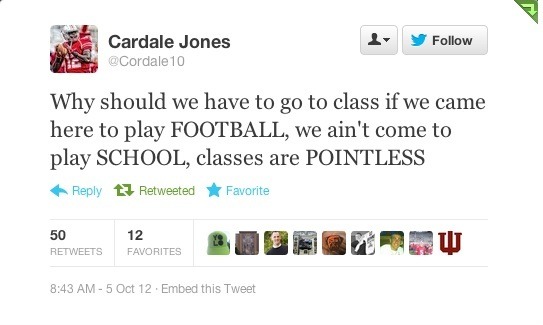While it
is possible for anyone to exercise poor judgement in their use of social media,
such gaffes are magnified when they are committed by popular or high-profile
individuals. College athletes are no
exception to this rule. Scrutinized by
the media, especially if they are gifted in a particular sport, or are a key contributor
to a successful sports program, college athletes have found that the high standards
expected of them on the field, also apply to their activities off the field and
on social media.
Let’s
take for example the story of Ohio State Buckeyes quarterback Cardale
Jones. A year before helping to lead the
Buckeyes to the first ever College Football Playoff National Championship,
Jones was a third-string freshman quarterback.
In a fit of frustration at having only gotten a B on a sociology exam, Jones
infamously tweeted the following: (Ward, 2014)
The
fallout from the ill-thought, impulsive tweet came quickly, as it immediately
went viral before finally being deleted, but not after sports news outlets,
including ESPN and The Bleacher Report,
picked up on the story and reported it. While
there was a smattering of support and sympathy for his plight, comments from
the online community about tweet varied from mostly mocking and poking fun at Jones
to outright insulting and disparaging him.
Ohio State would go on to suspend him for one game, issuing a statement
reminding their students who use social media to be “respectful, appropriate
and aware that their communications can impact many people” and to “remember
not to post or tweet anything that could embarrass themselves, their team,
teammates, the university, their family or other groups, organizations or
people” (Cardale Jones: Classes pointless,
2012). In an
instant, Cardale Jones had gone from a promising young athlete to an internet
punchline. Ole Miss went so far as to
use Jones’s tweet in a textbook for its freshmen students as an example of what
not to do on social media (Watson, 2013).
To his credit, however, Jones appears to have taken the lessons of his
poor experience with Twitter to heart. According
to Buckeyes head coach, Urban Meyer, a full two years after the incident, Jones
was now “one of the most improved players I've ever been around. The correlation between handling your
business off the field and on the field, he does a good job in the classroom now.
It wasn't pleasant his first year here ... but he's changed.” And in Jones’s own words, "You know, I
can take the heat from people from the outside looking in. But I was more
worried about the fact that I embarrassed the university, the football program
and definitely my family. That's what I cared about. Just growing up, I'd say
that was one of the steppingstones" (Ward, 2014).
So what are the solutions to this problem? Should Ohio State go so far as to ban the use of
social media for their athletes in order to protect their reputations and the
reputations of their sports programs? How about monitoring students' social media usage? Personally, I think such methods are reactionary and do little to
address the heart of the problem, which is properly educating students in the use of social media. Colgate
University encourages its student-athletes to actively participate in social
media, but also educates them “on what should be said as opposed to what
shouldn’t be” and using the platforms in positive ways to market themselves and
make themselves more attractive to recruiters and potential employers
(Grasgreen, 2013). Likewise, monitoring companies
like Varsity Monitor and UDiligence can help manage and respond to incidents
quickly, but the key to preventing social media mistakes starts with educating
the users.
References:
Cardale Jones: Classes pointless [article]. (2012, October 6). Retrieved
from http://espn.go.com/college-football/story/_/id/8466428/ohio-state-buckeyes-cardale-jones-tweets-classes-pointless
Grasgreen,
A. (2013, August 20). Tweet smart, tweet
often [article]. Retrieved from https://www.insidehighered.com/news/2013/08/20/instead-telling-athletes-not-tweet-colgate-shows-how-social-media-can-work-them
Kerpen, D. (2011). Likeable social media: How to delight your customers, create an
irresistible brand,and be generally amazing on Facebook (and other social
networks). New York, N.Y.:McGraw-Hill
Ward, A.
(2014, December 23). Infamous Cardale Jones tweet a
'steppingstone' [article]. Retrieved from http://espn.go.com/blog/bigten/post/_/id/113177/infamous-cardale-jones-tweet-a-stepping-stone
Watson,
G. (2013, October 22). Infamous Ohio
State tweet ends up in an Ole Miss textbook [article]. Retrieved from http://spo



.jpg)
.jpg)
.jpg)
.jpg)